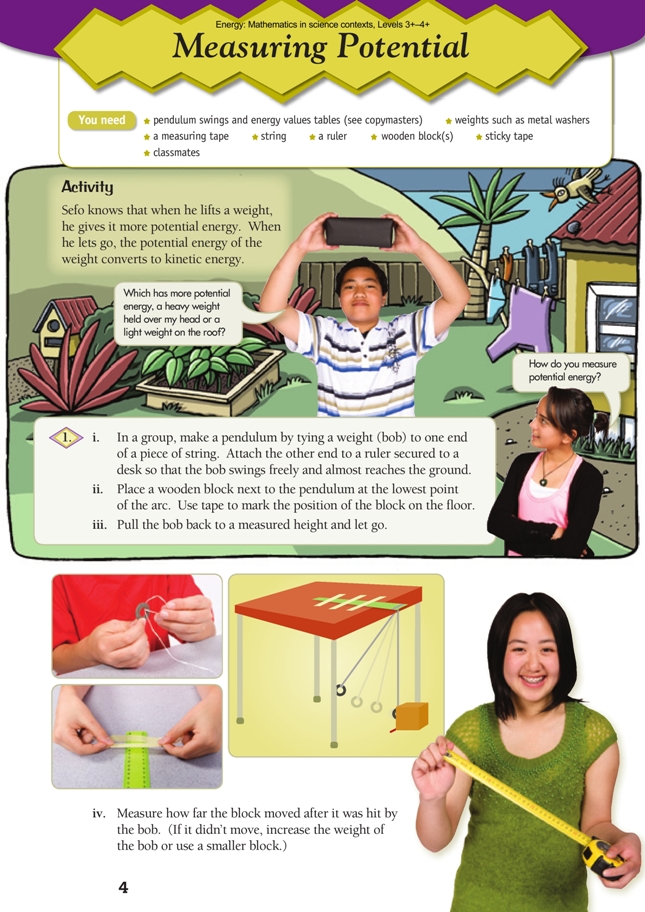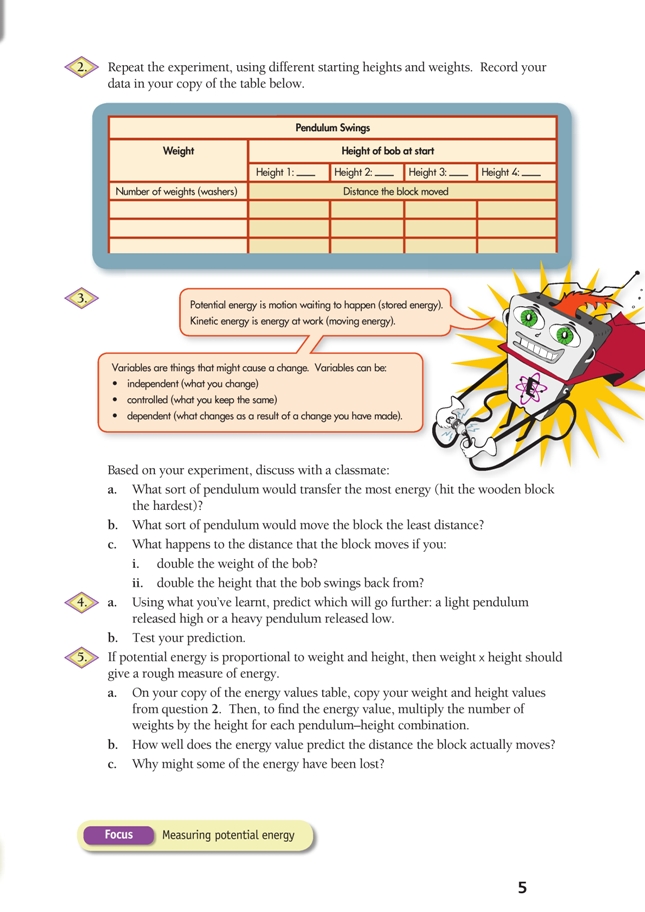This is a level (3+ to 4+) mathematics in science contexts activity from the Figure It Out series.
A PDF of the student activity is included.
Click on the image to enlarge it. Click again to close. Download PDF (1569 KB)
Students will:
- carry out a statistical investigation into the relationship between weight, height, and potential energy
- measure and record weight, height, and energy data
- identify relationships in their data, judge their accuracy, and use the relationships to make predictions.
Students should discover that:
- potential energy is proportional to weight x height
- friction and experimental error affects this relationship.
a ruler
wooden block(s)
sticky tape
a measuring tape
weights such as metal washers
pendulum swings and energy values table (see copymasters)
classmates
FIO, Energy, Levels 3+-4+, Measuring Potential, pages 4 - 5
Preparation and points to note
Ensure that there is enough working space for each group to work comfortably. Choose and brief the groups carefully. Consider setting up a demonstration pendulum* so that the students are clear about what to do.
Your students may not be familiar with the terms arc, pendulum, and proportional. Revise these as needed.
Encourage the students to discuss their results with other groups. This will reinforce the key competency thinking by providing opportunities for students to learn from their mistakes, improve their processes, and refi ne their conclusions.
Note that weight is the correct term in relation to the action of the bob. (Mass is a measure of how much matter is in an object. Weight is the force of gravity acting on mass – in other words, a measure of how hard gravity is pulling on an object. For more information, see the teacher support material for Figure It Out, Forces, levels 2+–3+.
Points of entry: Mathematics
This activity is about the relationship between weight, height, and potential energy. Relationships are the foundation of algebra and are responsible for all patterns. For example, the numbers in the sequence 3, 6, 9, 12, 15 … conform to a pattern: each is 3 greater than the number before it, and each is 3 times its position in the sequence (3n). Wherever we can fi nd and describe a pattern (that is, form a generalisation from particular instances), we can make predictions with confi dence.
Discuss what variables are (see the defi nitions on page 5 of the students’ book) and why they are important. (They tell other people who might like to repeat the experiment exactly what was changed and what was measured.) Discuss what the variables are in questions 2 and 3 and what type of variable they are in this context.
Reinforce the notions of dependent and independent variables and focus the students on fi nding relationships between them. (If there is no relationship, the dependent variable is not actually dependent!) Ask: What did we change? What did we keep the same? What conclusion(s) can we reach?
[Note for teachers. The relationship being explored here is E = mgh where E is potential energy, mg is the weight of the bob (mass x gravity), and h is the height. There are two independent variables (weight and height). If height stays the same and weight doubles, energy doubles; if weight stays the same and height doubles, energy doubles. If both weight and height are doubled, energy increases by a factor of 2 x 2 = 4.]
Careful measurement is the key to getting meaningful results in this activity. To make measurement easier, encourage the students to make signifi cant changes in height and weight, as opposed to small changes. For example, they will probably get better data using bobs of 10 washers, 20 washers, and 30 washers than trying to precisely measure the differences between results from bobs of 5, 6, and 7 washers. It is therefore important that students work out a method that allows them to take consistent measurements to a good level of accuracy. As always, encourage the students to take multiple measurements for each combination of variables and average them in order to reduce the impact of measurement variation. And, as with any statistical investigation, reinforce the phases of the statistical enquiry cycle: problem, plan, data, analysis, and conclusion.
You could challenge the students to create a visual representation of their data – one that clearly shows the relationship between the variables.
Points of entry: Science
Use Sefo’s question as an entry into this activity. All students will have had experiences with falling objects, and they may already have theories about the relative infl uence of weight and height. Ask them to share their examples and express their views. Ask What evidence do you have (to support your theory)?
Potential energy is an abstract quantity (the product of weight [mass x acceleration due to gravity] and height). But if students can link it to their own experience, they can give it meaning. Suggest: Pain is also an abstract quantity, but you can be sure that getting hit by a heavier pendulum will hurt more.
The pendulum experiment is an ideal classroom investigation. It provides a great opportunity for students to learn how to devise and run a good experiment that will give them data on which to base a valid conclusion. While it is important that students know what they are about to do and why, avoid over-specifying and thereby denying them the chance to develop their own methodology and do their own learning.
The students will probably introduce considerable error into their data; treat this as a learning opportunity, not a negative. Encourage them to track down the possible sources of error and to evaluate the impact of these on their data. They need to understand that error is something that prevents them from clearly identifying what is really happening. It can be diffi cult to eliminate all sources of error, especially in simple experimental set-ups like this one, so the emphasis needs to be on reducing/minimising them.
Additionally, in energy experiments, it is impossible to get “perfect” data because energy is always lost to friction.
Answers
1. Practical activity
2. Results will vary. Increasing the height or the weight will increase the distance that the wood block travels. For example, if 2 weights released from a height of 30 cm move the block 5 cm, then 3 weights released from the same height should move the block more than 5 cm. Similarly, 2 weights released from a height of 40 cm should move the block more than 5 cm.
3. a. The pendulum with the greatest weight released from the greatest height would transfer the most energy.
b. The pendulum with the least weight released from the least height would move the block the least distance.
c. i. If you double the weight of the bob, the block should move double the distance.
ii. If you double the height of the back swing, the block should move double the distance.
4. a. Answers will vary. A light pendulum released high or a heavy pendulum released low can have similar energy, so the block could move about the same amount.
b. You should be able to prove your prediction by experimentation.
5. a. Results should be similar to those in the table in question 2.
b. The energy value should be a good predictor of distance.
c. Energy will be lost in friction as the block slides along the fl oor. Also, if the bob does not strike the block cleanly in the centre of its mass, some of the pendulum’s energy will not transfer to the block.

